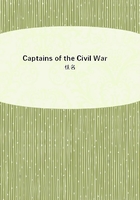
第12章 THE CLASH: 1861(11)
But, as we shall presently see, it was nearly two whole days before the last of Johnston's brigades arrived, just in time for the crisis of the battle. When Johnston had joined Beauregard their united effective total was thirty thousand men. There had been a wastage of three thousand. McDowell also had no more than thirty thousand effectives present on the twenty-first; for he left one division at Centreville and lost the rest by straggling and by the way in which the battery and battalion already mentioned had "claimed their discharge" at Blackburn's Ford.
Throughout the nineteenth and twentieth, while, sorely against his will, the Federals were having their "monster military picnic" at Centreville, he was reconnoitering his constantly increasing enemy under the greatest difficulties, with his ill-trained staff, bad maps, and lack of proper guides.
Lee had chosen six miles of Bull Run as a good defensive position. But Beauregard intended to attack, hoping to profit by the Federal disjointedness. Consequently none of the eight fords were strongly defended except at Union Mills on the extreme right and the Stone Bridge on the extreme left, where the turnpike from Centreville to Warrenton crossed the Run. Bull Run itself was a considerable obstacle, having fairly high banks and running along the Confederate front like the ditch of a fortress. Three miles in rear stood Manassas Junction on a moderate plateau intersected by several creeks. The most important of these creeks, Young's Branch, joined Bull Run on the extreme left, near the Stone Bridge and Warrenton turnpike, after flowing through the little valley between the Henry Hill and Matthews Hill. Three miles in front, across Bull Run, stood Centreville, the Federal camp and field base during the battle.
Sunday, July 21, 1861, was a beautiful midsummer day. Both armies were stirring soon after dawn. But a miscarriage of orders delayed the Confederate offensive so much that the initiative of attack passed to the Federals, who advanced against the Stone Bridge shortly after six. This attack, however, though made by a whole division against a single small brigade, was immediately recognized as a mere feint when, two hours later, Evans, commanding the Confederate brigade, saw dense clouds of dust rising above the woods on his left front, where the road crossed Sudley Springs, nearly two miles beyond his own left. Perceiving that this new development must be a regular attempt to turn the whole Confederate left by crossing Bull Run, he sent back word to Beauregard, posted some men to hold the Stone Bridge, and marched the rest to crown the Matthews Hill, facing Sudley Springs a mile away. Meanwhile four of "Joe" Johnston's five Shenandoah brigades--Bee's, Bartow's, Bonham's, and Jackson's--had been coming over from the right reserve to strengthen Evans at the Bridge. As the great Federal turning movement developed against the Confederate left these brigades followed Evans and were themselves followed by other troops, till the real battle raged not along Bull Run but across the Matthews Hill and Henry Hill.
Forming the new front at right angles to the old, so as to attack and defend the Confederate left on the Matthews and Henry Hills, caused much confusion on both sides; but more on the Federal, as the Confederates knew the ground better. By eleven Bee had reached Evans and sent word back to hurry Bartow on. But the Federals, having double numbers and a great preponderance in guns, soon drove the Confederates off the Matthews Hill. As the Confederates recrossed Young's Branch and climbed the Henry Hill the regular artillery of the Federals limbered up smartly, galloped across the Matthews Hill, and from its nearer slope plied the retreating Confederates on the opposite slope with admirably served shell. Under this fire the raw Confederates ran in confusion, while their uncovered guns galloped back to find a new position. "Curse them for deserting the guns," snapped Imboden, whose battery came face to face with Jackson's brigade.
"I'll support you," said Jackson, "unlimber right here." At the same time, half-past eleven, Bee galloped up on his foaming charger, saying, "General, they're beating us back." "Then, Sir,"said Jackson, "we'll give them the bayonet"; and his lips shut tight as a vice.
Bee then went back behind the Henry Hill, where his broken brigade was trying to rally, and, pointing toward the crest with his sword, shouted in a voice of thunder: "Rally behind the Virginians! Look! There's Jackson standing like a stone wall!"From that one cry of battle Stonewall Jackson got his name.
While the rest of the Shenandoahs were rallying, in rear of Jackson, Beauregard and Johnston came up, followed by two batteries. Miles behind them, all the men that could be spared from the fords were coming too. But the Federals on the Matthews Hill were still in more than double numbers; and they enjoyed the priceless advantage of having some regulars among them. If the Federal division at the Stone Bridge had only pushed home its attack at this favorable moment the Confederates must have been defeated. But the division again fumbled about to little purpose;and for the second time McDowell's admirable plan was spoilt.
It was now past noon on that sweltering midsummer day; and there was a welcome lull for the rallying Confederates while the Federals were coming down the Matthews Hill, struggling across the swamps and thickets of Young's Branch, and climbing the Henry Hill. Within another hour the opposing forces were at close grips again, and the Federals, flushed with success and steadied by the regulars, seemed certain to succeed.
Imboden has vividly described his meeting Jackson at this time.